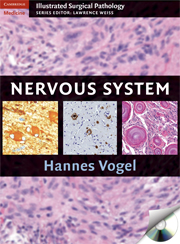Book contents
- Frontmatter
- Contents
- Contributors
- Preface
- Acknowledgments
- 1 Normal Anatomy and Histology of the CNS
- 2 Intraoperative Consultation
- 3 Brain Tumors
- 4 Vascular and Hemorrhagic Lesions
- 5 Infections of the CNS
- 6 Inflammatory Diseases
- 7 Surgical Neuropathology of Epilepsy
- 8 Cytopathology of Cerebrospinal Fluid
- Index
8 - Cytopathology of Cerebrospinal Fluid
Published online by Cambridge University Press: 04 August 2010
- Frontmatter
- Contents
- Contributors
- Preface
- Acknowledgments
- 1 Normal Anatomy and Histology of the CNS
- 2 Intraoperative Consultation
- 3 Brain Tumors
- 4 Vascular and Hemorrhagic Lesions
- 5 Infections of the CNS
- 6 Inflammatory Diseases
- 7 Surgical Neuropathology of Epilepsy
- 8 Cytopathology of Cerebrospinal Fluid
- Index
Summary
CLINICAL INDICATIONS
Examination of cerebrospinal fluid (CSF) specimens is a routine component of most neurological evaluations and includes cell count, biochemical analysis, and cytological examination. Samples may be obtained by lumbar puncture or from the lateral ventricles or cisterna magna either at the time of surgery or from indwelling ventricular shunts. CSF analysis is not only useful for diagnosis of new neoplastic processes, but is routinely used for monitoring the efficacy of central nervous system (CNS) chemotherapy such as recurrence of lymphoma or leukemia and or in the evaluation of infections in immunocompromised patients. As with other aspects of cytology, the cytological findings must be correlated with the clinical, biochemical, and radiographic findings to ensure diagnostic accuracy.
SPECIMEN PREPARATION (CYTOPREPARATION)
CSF specimens are unique in cytology with respect to the small sample size, lack of cellular abundance, and susceptibility of the sample to undergo rapid degeneration. With this in mind, processing of CSF specimens for cell count, biochemical analysis, cytological preparation, and additional tests such as flow cytometric analysis in cases of suspected hematopoietic malignancies should be done as soon as possible. The specimen is collected in plastic tubes and divided among several divisions within the laboratory for specific testing Cytological diagnosis should be performed from the third or last tube since it will have less blood contamination in cases of traumatic tap.
The most common stain employed in CSF cytology is the Wright–Giemsa preparation, which is most useful for classification of hematopoietic cells and cytoplasmic detail while the Papanicolaou stain, best for nuclear detail, is the standard used for filter and cytocentrifugation preparations.
- Type
- Chapter
- Information
- Nervous System , pp. 477 - 492Publisher: Cambridge University PressPrint publication year: 2009

